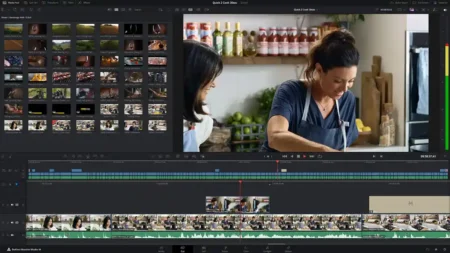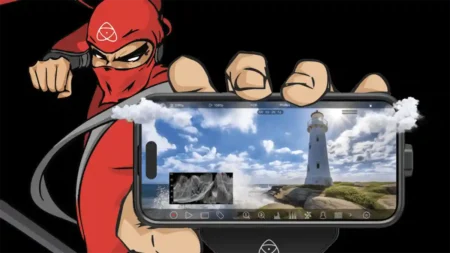Snap Verdict
The Ricoh Theta SC may not bowl you over with its headline specs, but it’s a surprisingly capable, take-anywhere camera with great image quality. It’s fun to use and is perfect for anyone making their first foray into 360 photography and videography.
What is the Ricoh Theta SC?
The Theta SC is Ricoh’s mid-class 360 camera launched in late 2016, weighing less than the company’s previous models at just 102g and measuring 45.2 x 130.6 x 22.9mm.
The Ricoh Theta SC also allows users to transfer their captured 360-degree images to smartphones and tablet computers, as well as upload their images to Ricoh’s theta360.com website and then share them on their social media pages. Theta SC users can also now upload 360-degree videos directly to Facebook and YouTube.
The Ricoh Theta SC is comprised of two cameras, with one f/2 lens facing forwards and another facing backwards.
Inside these two cameras there are two 1/2.3-inch type, 12-million-pixel image sensors. Internal processing within the Theta SC then merges images or video from these two sensors into one 360-degree picture.
Each still image is made up of around 14-megapixels, and the Ricoh Theta SC can record video at up to Full HD quality (1920 x 1080) at 30 frames per second.
The Theta SC also boasts 8GB of internal memory, which equates to about 1600 images or 63 minutes of Full HD video.
Ricoh has also streamlined the controls on the Theta SC, adding a switch on the side of the body allowing users to swap between stills and video, which previous Theta cameras didn’t have.
You can also use your smartphone (iOS or Android) via a Theta app to take full control of the camera with a range of manual exposure controls.
The Ricoh Theta SC was original £249.99 upon its launch, but Ricoh has since cut the price by £100/$100, making it one of the more affordable options on the market.

Build & Handling
On top of the Ricoh Theta SC are six small holes that serve dual purposes as a speaker and microphone.
Underneath the camera is its tripod mount thread and a micro USB terminal for charging the 360 camera.
Only one side of the Ricoh Theta SC has buttons, and here you’ll find the Power button. This lights blue when the power is on and flashes blue when the battery is running low.
Below the power button is the WiFi button. When the power is turned on while holding this button, the Theta SC turns on with the self-timer.
And below the WiFi button is the Capture Mode button where you can switch between still image and video capture.
On the front side of the Ricoh Theta SC you’ll find the camera’s status lamp which indicates whether it’s on and ready for capture. Beneath that is the circular shutter button, and below that is a lamp to indicate whether the WiFi is activated. If this light is flashing, your Theta SC is not connected to WiFi.
At the bottom of the side of the Ricoh Theta SC that boasts all the control buttons you’ll also find a capture mode lamp that illuminates the still or video icon depending on what mode you’re using.
Ricoh Theta SC app
The Ricoh Theta SC uses the same companion app as the Theta S, and is branded as such on Play and iTunes. I wrote about the Theta S app extensively in my Ricoh Theta S review, where I explain step by step how to connect your Theta to the app and get started using your phone as a remote control for your 360 shooting.
So I won’t say too much more about the Ricoh Theta app again here but to say that it’s one of the better apps out there. It’s simple to connect and get started with. There is a fair amount of control over the look and style of your images and video, and transferring them to social media or cloud storage like Google Photos is a breeze.
I’ve found that a lot of 360 cameras are made or broken by their apps. I’ve used some beautifully designed cameras with sophisticated specs, but a lack of functionality within the app tends to limit the experience. Companies like Ricoh, 360Fly and a few others clearly put a lot of thought into making their 360 cameras’ companion apps enhance the user’s experience.
Performance
The Ricoh Theta SC powers on straightaway, and if using the 360 camera’s shutter button you can be taking photos or videos within a couple seconds. Once the camera is on, simply select your Capture Mode via the dedicated control underneath the power button and you’re ready to go.
Otherwise, then launch the app on your phone and connect to the Ricoh Theta SC’s WiFi, which only takes about 10secs or so. The app’s remote control is really the best way to use the Theta SC to its full potential.
Like the Ricoh Theta S, I was quite pleased with the Theta SC’s image quality. Though many 360 cameras offer 4K resolution, you have to take in consideration the size of the sensors in these devices and that a 4K image or video is being stretched across 360 degrees. So these headline specs can be a little misleading sometimes in terms of expectations if you’ve not used a 360 camera before.
The Theta SC offers full HD video at 30fps video resolution and 5376 x 2688 still image resolution in its largest file option, so stretched 360 degrees I was prepared for overwhelming fringing and smudging of detail.
And while there’s some softness in detail, it’s about what you’d expect from any 360 camera. Overall, I found the colours punchy and exposures handled very well.
For instance, bright skies, as in the image at the top of this page (which isn’t proper immersive 360, as web platforms are still catching up), may not have much detail, but there isn’t much fringing.
And because of the Theta SC’s range of exposure controls within the app you can, for instance, add some exposure compensation (up to +/- 2EV) or try a different white balance mode in these situations. There’s a surprising amount of manual control for a camera at this price point.
Like the Theta S, I also found that the stitch in the Ricoh Theta SC photos and videos was, well, pretty seamless. Mostly. There were a few times where my hand (when holding the Theta SC) didn’t line up, but never did I find the odd lines running longitudinal through my scenes like I have on some other cameras.
If you look at the images below taken in a shop, you can see the seam along my hand lines up almost perfectly.
Overall, the Theta SC did a great job with its in-camera stitching during my tests.
Verdict
The pace of development in the 360 camera market is very fast, much like DSLRs in the middle part of the last decade, and while the Theta SC may have been passed by some of its contemporaries in terms of spec, it really holds its own.
Ricoh has been savvy with managing the Theta SC, cutting its price strategically as other cameras have come on the market, including its new Theta V, to reposition it as a sort of entry-level 360 camera. And on this level I think it really succeeds.
At around £150/$150 street price, the Ricoh Theta SC offers a lot of manual control if not the biggest resolution numbers. And it also… just works. You’d be surprised how many don’t and feel like they are unfinished products.
The Ricoh Theta SC is a dependable, affordable 360 camera that is the perfect tool for someone just looking to make the jump into 360 media capture to see if it’s for them. It’s a 360 camera you can not only learn quickly on, but also grow with.
Should I buy a Ricoh Theta SC?
Yes. If you’re looking for a dedicated 360 camera that offers a bit more control and capability than your iPhone’s gyroscope, then the Ricoh Theta SC is the perfect camera for you to make the leap into more serious 360 photography and videography.
Likewise, if you’re intrigued by the format but unsure if you’ll really use a 360 camera all that often, rather than splashing out on the sexier GoPro Fusion or Garmin Virb 360, the Ricoh Theta SC is an affordable, well-built device on which you can test your interest.



